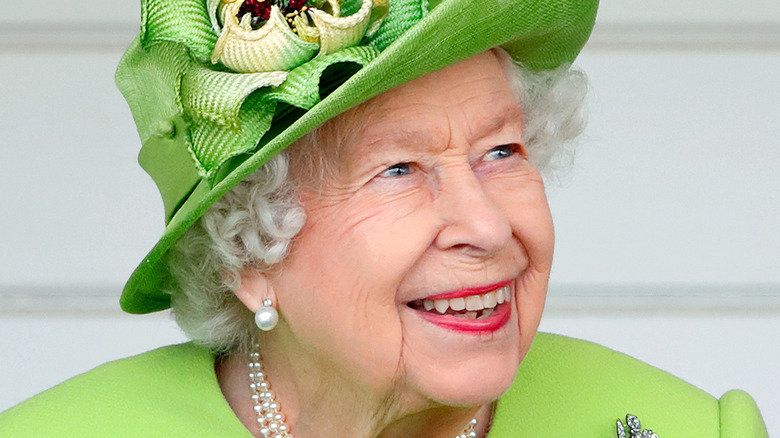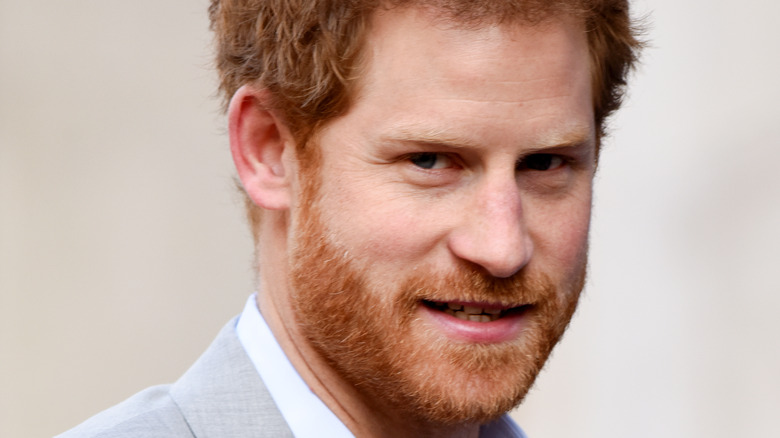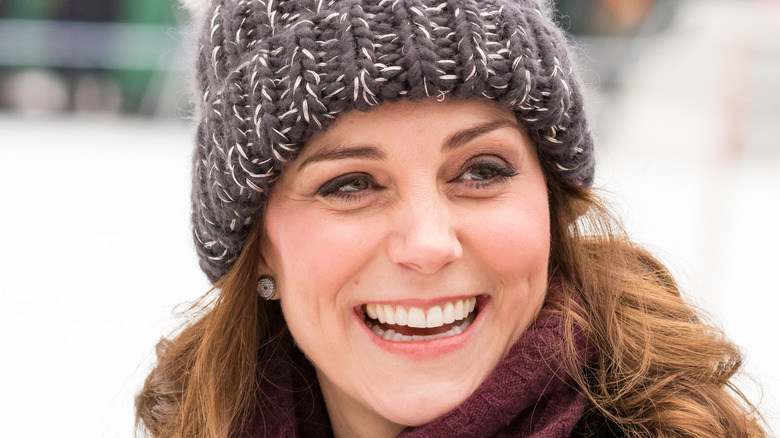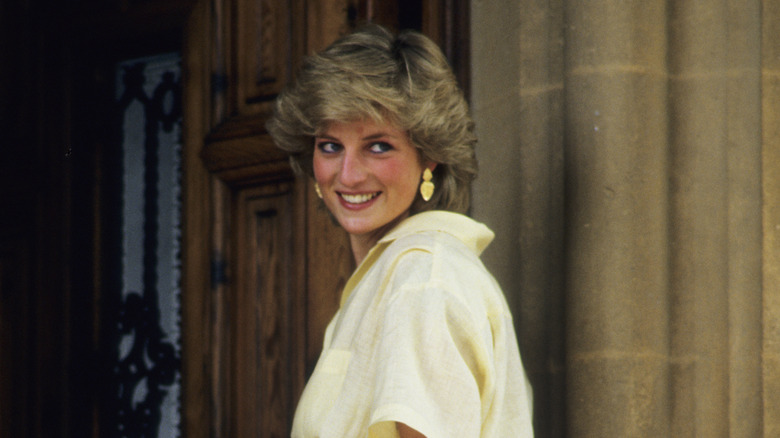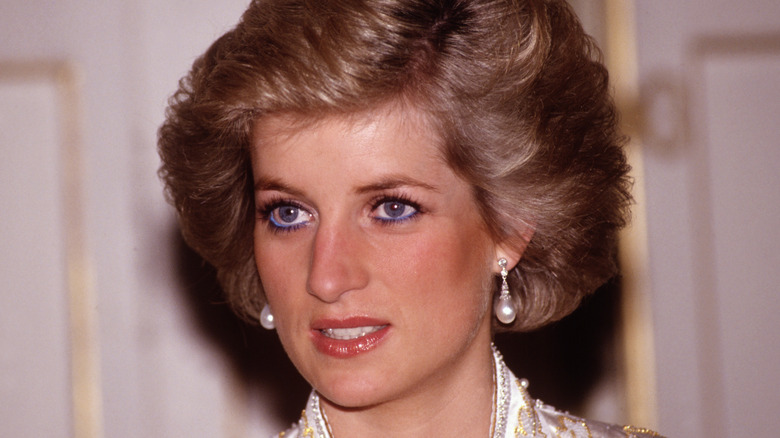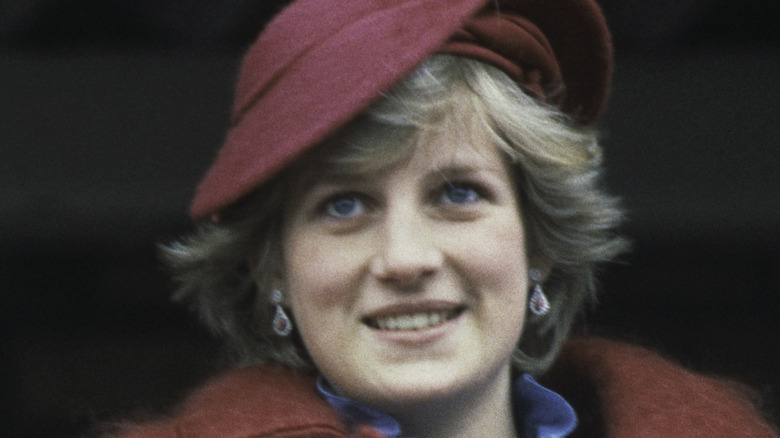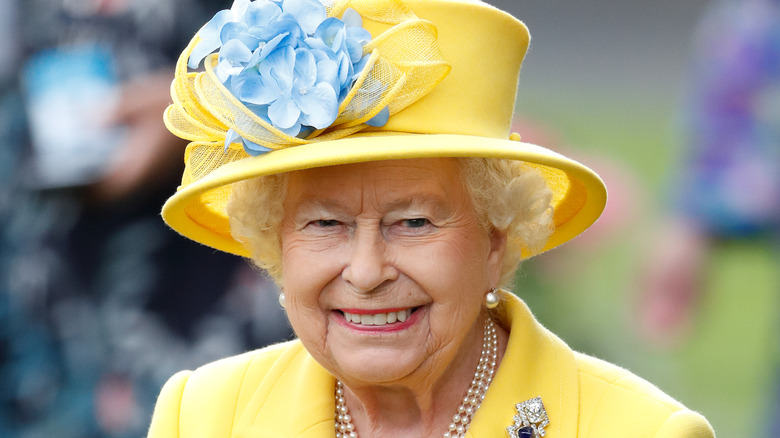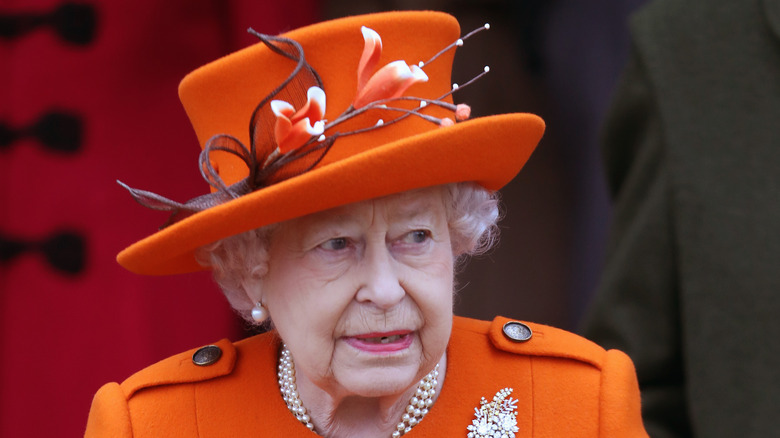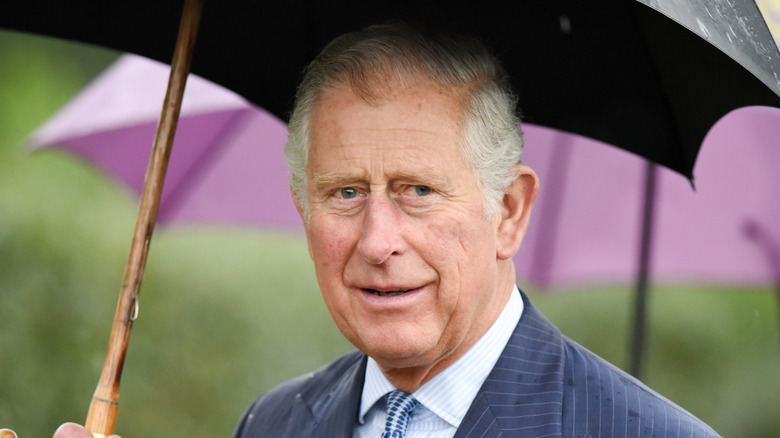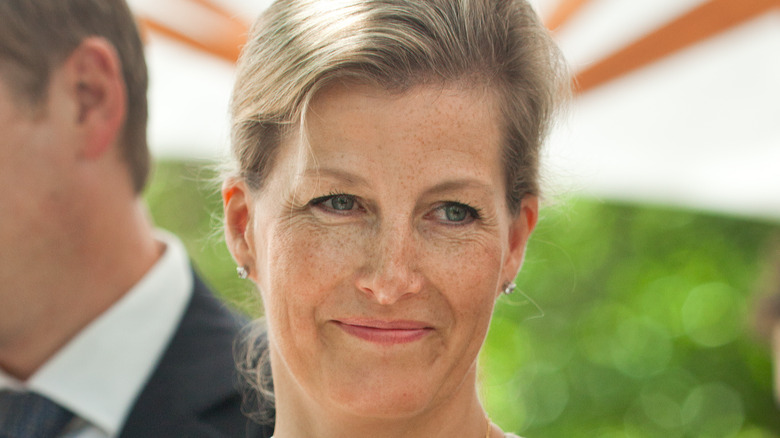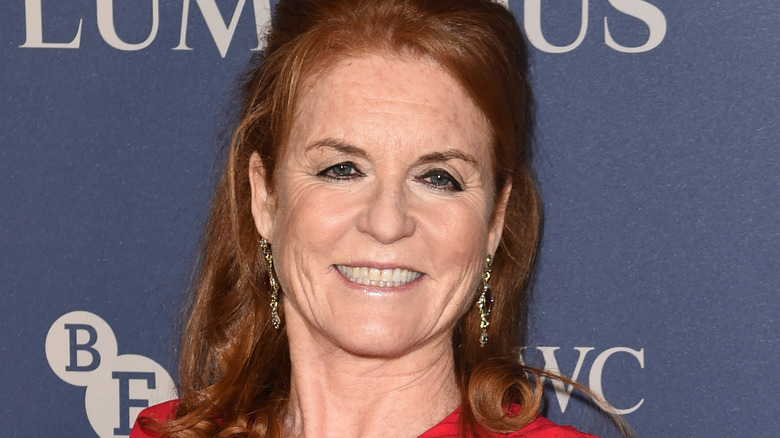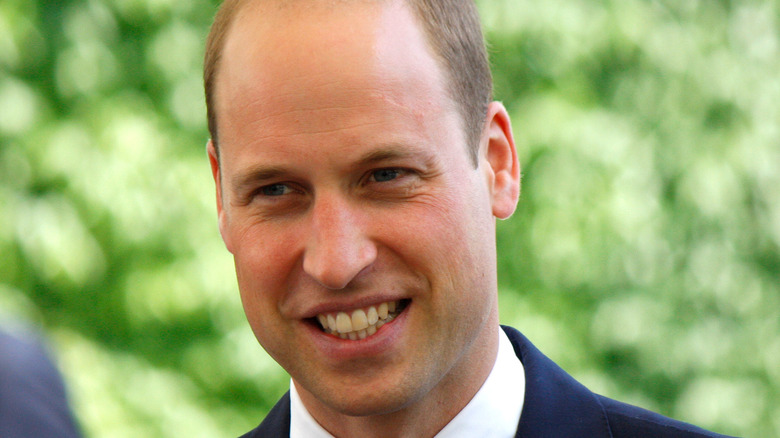British Royal Hoaxes That Had Everyone Confused
In February 2022, Buckingham Palace revealed that Queen Elizabeth had been diagnosed with COVID-19. Within days, a website called HollywoodUnlocked began insisting that the Queen had died from the condition. The internet immediately flew into a frenzy, though the rumor was quickly squashed by Buckingham Palace (as shared by Newsweek).
While the Queen herself is no stranger to rumors of her own mortal demise, other members of the royal family have also fallen victim to a variety of scandals and hoaxes. As many people might recall, in 2020 Prince Harry believed he was speaking to activist Greta Thunberg when he revealed his real feelings about former U.S. President Donald Trump (via The Guardian), much as his own mother fell victim to a prank phone call all the way back in 1996 (per the Daily Mail).
Here's a breakdown of a few hoaxes that various members of the British royal family have been victim to. While some have had pretty serious consequences, others appear to have been shrugged off through the sands of time.
Prince Harry thought he was speaking to Greta Thunberg
In March 2020, the world found out that Prince Harry was duped by prank callers not once but twice. Harry ended up engaged in a phone call with two people masquerading as environmental activist Greta Thunberg and her father, but who in reality were professional Russian hoaxers Vladimir Kuznetsov and Alexey Stolyarov. As The Guardian reported, the pair were able to communicate by phone with Harry while he was in Canada with his wife, Meghan Markle, and their son Archie.
Harry didn't reveal anything too dramatic in the phone calls, apart from a disdain for former American president Donald Trump and for the tabloid papers that continue to hound himself and Meghan, but royal courtiers and watchers alike sounded alarm bells about the fact that the hoaxers were able to make contact in the first place. As the Queen's former press secretary Dickie Arbiter told The Guardian, the successful calls indicated a concerning lack of security surrounding the Sussexes. He said, "As long as Harry and Meghan are over there, they're out of the protection of the system. For all its faults, the system does, and is there to, protect."
Australian DJs managed to place a phone call to Kate Middleton's hospital
Kate Middleton was hospitalized in December 2012 when a pair of DJs at an Australian radio station placed a phone call to the King Edward VII Hospital, claiming to be Queen Elizabeth and Prince Charles. The pair were able to fool the staff at the hospital, who divulged personal information about Kate's condition. The hospital later confirmed they'd been duped, with its chief executive John Lofthouse commenting, "This was a foolish prank call that we all deplore. We take patient confidentiality extremely seriously and we are now reviewing our telephone protocols" (via Reuters).
While the call might have seemed funny at the time, it had dire consequences. Jacintha Saldanha, the nurse who connected the callers with the ward Kate was staying in, was found hanged days later. She left behind a note that read, "'I hold the Radio Australians Mel Greig and Michael Christian responsible for this act. Please make them pay my mortgage. I am sorry. Jacintha" (via the Daily Mail).
Prince William later wrote a letter to Saldanha's husband, who shared parts of it with The Guardian. William wrote, "Jacintha and her colleagues looked after us extremely well and I am just so sorry that someone who cared for others so much found themselves in such a desperate situation."
An M15 agent "confessed" to killing Princess Diana
In June 2017, the world of royal watchers drew a collective breath when a story alleging that a retired M15 agent had confessed to killing Princess Diana was dropped. As Marie Claire shared, the tale went like this: At the age of 80, alleged retired agent John Hopkins had been told he had only weeks to live. Feeling a sudden sense of unease, Hopkins decided to confess to a major crime.
In fact, he supposedly confessed to a total of 23 assassinations, with the death of Princess Diana being the only time he pursued a woman. This was also, supposedly, the only "job" that had come directly from the royal family.
The story was eventually discredited when websites such as Snopes pointed out that the original "source," a website called YourNewsWire, was known for spreading conspiracy theories, misinformation, and full-scale lies.
Princess Diana once thought she was on the phone with Stephen Hawking
In 1996, television broadcaster Victor Lewis-Smith picked up the phone and somehow managed to get all the way to Princess Diana. Once connected to Diana, Lewis-Smith managed to convince her that she was speaking to none other than internationally-acclaimed physicist Stephen Hawking.
The Daily Mail reported that at the beginning of the call, the two go back and forth about Diana's ex-husband, Prince Charles, and former American president Bill Clinton. Then Lewis-Smith went in for the kill: He asked Diana how rugby captain Will Carling was doing. At the time, Diana was rumored to be in a relationship with Carling, but she didn't bite.
The whole phone call took place after Lewis-Smith called up Buckingham Palace and claimed to be the public relations person for Hawking. Diana's private secretary Patrick Jephson intercepted the call, and connected her to Lewis-Smith days later. One thing led to another, and this particular phone call will certainly live on in infamy.
The Sun ran a fake video of Princess Diana and James Hewitt
Princess Diana and her personal life were certainly the focal point of quite a few royal hoaxes in her lifetime. In 1996, a video that allegedly depicted Diana with her rumored affair partner James Hewitt was circulated; The Sun claimed the 80-second-long video clip was of the two "frolicking" together. As CNN later noted, it turned out the entire video was a complete hoax, but that wasn't revealed until after the fact.
Diana's spokesperson at Kensington Palace was quick to deny the claims made by The Sun, telling CNN, "The Princess of Wales has authorized me to tell you that she does not recognize either herself or Major James Hewitt in these photographs." While Stuart Higgins, the editor of The Sun at the time, tried to insist the video was authentic, he later admitted he was wrong.
Higgins explained, "I believe The Sun and myself were victims of a sophisticated hoax deliberately aimed at embarrassing myself and The Sun newspaper which prides itself on getting things right and has established a reputation for doing so" (via CNN).
Queen Elizabeth thought she was on the phone with the Canadian prime minister
In 1995, Queen Elizabeth was victim to her own phone call hoax when a Canadian radio DJ by the name of Pierre Brassard got through to the monarch and enjoyed a 17-minute phone call in which he pretended to be Prime Minister Jean Chretien. The DJ later explained that getting in touch with Queen Elizabeth was as easy as calling Buckingham Palace and asking to be connected (per The Mirror).
While participating in a documentary about the Queen in which the phone call came up, royal expert Richard Kay marveled at the monarch's more relaxed voice in the call. As he put it, "She hasn't got the formal voice on and she comes across as incredibly relaxed, and enjoying the encounter. It's absolutely extraordinary. She picks up the call as if it's an every day thing, and of course, it was an every day thing."
The fallout from the call was swift, and there was an entire change up at Buckingham Palace going forward. The Mirror notes that calls from then on have been staggered, first passing through the Private Secretary. From there, the Queen will call back on her own line, ensuring that no one is recording.
There have been numerous hoaxes claiming Queen Elizabeth is dead
While February 2022 saw a fresh round of hoaxes pertaining to whether or not Queen Elizabeth was still alive (per PolitiFact), it was hardly the first time that the monarch had to contend to rumors of her own mortality. In 2016, Twitter was hit with a wave of #mediablackout hashtags, which began, as the BBC reported, because some people believed Queen Elizabeth had died.
At the time, Queen Elizabeth had missed events around Christmas 2016 because she was sick. A few days later, a Twitter user posted a tweet asking if there really was a media blackout, as his wife had seen a rumor about it on Facebook. From there, a fake account designed to be very similar to the BBC's began using the hashtag to tweet that the Queen had passed away. Eventually, the rumor was squashed as people realized the account was fake.
In February 2022, Buckingham Palace announced that the Queen had contracted COVID-19. Within days, a website called Hollywood Unlocked announced the Queen's death, and founder Jason Lee doubled down on the claim on Twitter. PopCulture, among other outlets, later verified that the Queen is still very much alive.
Prince Charles was fooled by a $134 million art hoax
In 2019, Prince Charles was pulled into a massive art scandal. It was discovered that multiple pieces of art in the Prince's Dumfries House estate home in Scotland had been created by an impressive forger, not the famous artists to whom the pieces were attributed. The alleged counterfeiter, Tony Tetro, who said he was hired by art collector James Stunt, admitted to the Mail on Sunday that he created paintings that were said to be from Monet, Picasso, and Dali and that the paintings were hanging in the home. For insurance purposes, the paintings were evaluated to be worth $134 million (via People).
The Prince's Foundation later issued a statement about the incident, admitting, "It is extremely regrettable that the authenticity of these particular few paintings, which are no longer on display, now appears to be in doubt."
The paintings had previously been authenticated by the Wildenstein Institute in Paris, and were loaned to the Dumfries House by Stunt, who bristled at the suggestion the paintings were fake. He told the Daily Mail, "None of these pictures have come back, they are all there. No Monet has come back to me because it is not real. None of my stuff is fake." The Mail, however, reports that the "Monet" was, in fact, sent back.
The Countess of Wessex had to leave her job after a fake meeting
In 2001, the Countess of Wessex was embroiled in a notoriously embarrassing scandal when she was tricked by journalist Mazher Mahmood into making very incriminating and embarrassing comments about both Prince Charles and former Prime Minister Tony Blair. Sophie, Countess of Wessex, was reportedly under the impression she was going to a meeting at the Dorchester hotel with a prince from Saudi Arabia who was looking for a public relations expert (per The Guardian). Instead, she was fooled into making comments that would come back to haunt her.
Sophie ended up owing huge apologies to both Charles and Blair, and wrote each of them letters asking for their forgiveness. Her comments about Blair included a dig at his wife, with Sophie saying, "He's ignorant of the countryside. His wife is even worse, she hates the countryside. She hates it!" (via The Guardian). She also commented on the relationship between Charles and Camilla Parker-Bowles, who were then dating. She said, "On the one hand there's no reason why she shouldn't be accepted because he's divorced and she's divorced, but then again you've got issues of the monarch being the head of the Church."
Sarah Ferguson was willing to give up information about Prince Andrew
In 2010, journalist Mazher Mahmood hit the royal family again. This time around, he was speaking to Sarah Ferguson, the ex-wife of Prince Andrew, and nearly managed to get insider information about Andrew — if he'd been willing to pay the hefty £500,000 price tag. As explained by The Guardian, Sarah was caught on video telling Mahmood, who she believed was a foreign businessman, that she could get access to Andrew for him.
After that, she's filmed explaining that if Mahmood will pay the amount, everything will go the way he wants it to. Sarah says, "That opens up everything you would ever wish for. I can open any door you want, and I will for you. Look after me and he'll look after you ... you'll get it back tenfold" (via The Guardian).
Sarah had to tearfully own up to the meeting once it came out and Andrew denied having any knowledge of the meeting whatsoever. In her statement, Sarah admitted her financial situation was "under stress" but that "that is no excuse for a serious lapse in judgment and I am very sorry that this has happened" (per The Guardian).
There was a fake Prince William account in the early days of Facebook
It's probably not too surprising that the early days of social media were pretty unusual, and even the royal family didn't entirely escape being wrapped up in Facebook's infant stage. Back in 2007, the Daily Mail revealed that Prince William had been the victim of a fake profile scam on the social media platform.
The account, which was created with the name William Wales, the same name that William used while he was a student at Eton. Most of the connections on the platform also seemed to be real people who have real life connections to the future king himself. The Daily Mail notes that one of those friends was named Katherine Middleton, but William's future wife spells her first name "Catherine."
At the time, Buckingham Palace opted out of directly addressing the possibility that William could be on social media at all, noting, "We would consider it a private thing and not comment on it." In the end, the Daily Mail chalked the entire profile up to a crafty hoaxer.
